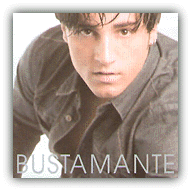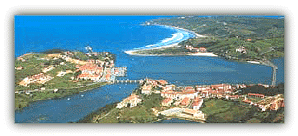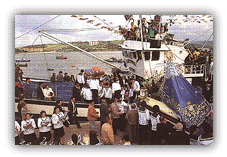

 |
![]()
Chino,
árabe, ruso, italiano, inglés, francés, aleman, euskera,
gallero, catalán, bable... exprésate en los idiomas que conozcas
y envíanos tu trabajo a esta sección, incluyendo también
la traducción, para que todos aprendamos un poco más.
La torre de BabelAulas
Un recorrido por San Vicente
Yo soy
Entrevistas
Un recorrido por San Vicente
Por Beatriz Ortego Balbás y Laura Alvarez Fuentevilla,
Alumnas de 1º Bachillerato A del colegio Nuestra Señora de La
Paz de Torrelavega.
Descripción de la historia, gastronomía, cultura y folclore de San Vicente de la Barquera, una de las villas marineras más importantes de Cantabria.
A tour around San Vicente
A description about the history, gastronomy, culture and folklore of San
Vicente de la Barquera, one of the most important sea villages in Cantabria.
Do you know San Vicente de la Barquera? Not yet? Then join us in a pleasant tour around one of the most interesting and with more prestige sea villages in Cantabria, a tourist centre in summer and nationally well-known.
We would like to tell you about San Vicente de la Barquera, our favourite village in Cantabria, which is northern Spain.
 It's not a very big town and there are only 5 thousand inhabitants, even though
in summer it's very busy and a lot of tourists come here, specially English
tourists, who come by Ferry to Santander. It takes you only thirty-five
minutes to go to San Vicente from Santander by car.
It's not a very big town and there are only 5 thousand inhabitants, even though
in summer it's very busy and a lot of tourists come here, specially English
tourists, who come by Ferry to Santander. It takes you only thirty-five
minutes to go to San Vicente from Santander by car.
What's more, since last year, this village has become really famous because of David Bustamante, a great young singer who was born here and sponsors his hometown wherever he goes, so it makes it even more interesting for their fans, who don't doubt about coming here and see the beautiful place.
The village is divided mainly into three areas: the town, La Barquera (the sailor's neighbourhood) and the beaches.
The first beach you come across is the smallest Tostadero beach, at the San Vicente estuary. It faces South and is protected from the winds by a pinewood forest. San Vicente is to be found on the other side of the estuary at the confluence of two rivers.

The other big beach is behind the pinewood forest, on the other side of the estuary. Next to the forest there is a campsite with a bar. And in front of it there is a not very expensive and good hotel.
To go into the town there's a large bridge made of stones (and there is another one to leave it). The main road is a national road and there's a park next to it. Actually, a bus station has been built where there was a park for children. Now, behind the bus station, there is a bigger park for children to play and a basketball court too.
 If you come into the town, you'll probably see a lot of buildings, some
bars and cafés, not many supermarkets but some shops with typical
gifts and food. One of the desserts better known in this village is the
ties, made with puff pastry. They originally come from Unquera, a
small town next to San Vicente. From the cuisine of this area, rich in fish
and shellfish dishes, we must mention the sorropotún, a stew
of tuna fish, potatoes, onions, tomato, peppers, bread, oil and salt.
If you come into the town, you'll probably see a lot of buildings, some
bars and cafés, not many supermarkets but some shops with typical
gifts and food. One of the desserts better known in this village is the
ties, made with puff pastry. They originally come from Unquera, a
small town next to San Vicente. From the cuisine of this area, rich in fish
and shellfish dishes, we must mention the sorropotún, a stew
of tuna fish, potatoes, onions, tomato, peppers, bread, oil and salt.
It's a seavillage so, obviously, it has a harbour with different kinds of ships and boats. But the sea port is in the La Barquera neighbourhood. There are also storerooms for ships equipment and a fish market.
The sailors and their families live in the apartments of the neighbourhood but there are also some good and comfortable hotels and semidetached houses.
 As you see in this photograph, this is the Santa María de los
Ángeles parish church. It's one of San Vicente's oldest monuments
and can be found in a setting above the town. This was a work which began
in the 13th century, as revealed by two of its Romanesque doorways, and
it was completed in the 16th century. There's also a castle and stone walls
to protect the town. Other admirable buildings include the old San Francisco
convent from the 16th century, the house which belonged to the Inquisitor
Corro in the 16th century and is now the City Council building.
As you see in this photograph, this is the Santa María de los
Ángeles parish church. It's one of San Vicente's oldest monuments
and can be found in a setting above the town. This was a work which began
in the 13th century, as revealed by two of its Romanesque doorways, and
it was completed in the 16th century. There's also a castle and stone walls
to protect the town. Other admirable buildings include the old San Francisco
convent from the 16th century, the house which belonged to the Inquisitor
Corro in the 16th century and is now the City Council building.
The most popular and traditional festivals take place near the sea. La Folía festival is a procession of the Virgin of La Folía. The statue of the Virgin is taken from the chapel in La Barquera, where it is kept the whole year, to the church Santa María de los Angeles.
 After the mass, in a procession, it's lead to the port, where a ship
will take her as far as the end of the estuary, followed by other ships.
It's very famous and a lot of people from different parts of the region
(and even from other parts of Spain) attend this procession on the second
Sunday after Easter. And another main festival is the Virgin of Carmen,
patroness of sailors, celebrated on July 16th.
After the mass, in a procession, it's lead to the port, where a ship
will take her as far as the end of the estuary, followed by other ships.
It's very famous and a lot of people from different parts of the region
(and even from other parts of Spain) attend this procession on the second
Sunday after Easter. And another main festival is the Virgin of Carmen,
patroness of sailors, celebrated on July 16th.
Traducción:
Un recorrido por San Vicente
Descripción de la historia, gastronomía, cultura y folclore
de San Vicente de la Barquera, una de las villas marineras más importantes
de Cantabria.
¿Conoces San Vicente? ¿Todavía no? Entonces acompáñanos en un ameno recorrido a lo largo de una de las villas marineras cántabras más interesantes y de mayor prestigio, centro turístico en verano y conocida nacionalmente.
Nos gustaría hablar sobre San Vicente de la Barquera, nuestro pueblo favorito en Cantabria, al norte de España.
No es un pueblo muy grande y sólo tiene unos cinco mil habitantes, aunque en verano está muy concurrido y muchos turistas vienen aquí, especialmente turistas ingleses, que vienen a Santander en el Ferry. Sólo te lleva treinta y cinco minutos ir en coche de Santander a San Vicente.
Además, desde el año pasado, este pueblo se ha hecho muy famoso debido a David Bustamante, un joven gran cantante que nació aquí y patrocina su ciudad natal allá donde va, lo que lo hace incluso más interesante para sus fans, que no dudan en venir a conocer el maravilloso lugar.
El pueblo se divide en tres partes: el pueblo, la Barquera (el barrio marinero) y las playas.
La primera playa que te encuentras es la pequeña playa de el Tostadero, en la ría de San Vicente. Está situada hacia el sur y protegida de los vientos por un pinar. San Vicente se encuentra en la otra parte de la ría, en la confluencia de dos ríos. La otra gran playa está detrás del pinar, al otro lado de la ría. Al lado del bosque, hay un camping con un bar. Y en frente, un buen hotel no muy caro.
Para entrar en el pueblo hay un largo puente hecho con piedras (y hay otro a la salida). La carretera principal es carretera nacional y hay un parque al lado. En realidad, una estación de autobuses ha sido construida donde se encontraba el parque para niños. Ahora, detrás de la estación, hay un parque más grande para que los niños puedan jugar y también canchas de baloncesto.
Si entras en el pueblo, verás probablemente un montón de edificios, algunos bares y cafeterías, no muchos supermercados pero sí algunas tiendas con recuerdos y comida típica. Uno de los postres más conocidos en este pueblo son las corbatas, hechas con hojaldre. Originariamente vienen de Unquera, una pequeña población al lado de San Vicente. De la cocina de este área, rica en platos de pescado y marisco, debemos mencionar el sorropotún, un guiso de atún, patatas, cebollas, tomate, pimiento, pan, aceite y sal.
Es una villa marinera, así que, obviamente, tiene un puerto con diferentes tipos de barcos y botes. Pero el puerto se encuentra en el barrio de la Barquera. Hay también bodegas para guardar el equipo pesquero y una lonja.
Los marineros y sus familiares viven en los pisos del barrio pero también hay algunos buenos y cómodos hoteles y chalets.
Como ves en esta fotografía, esta es la iglesia parroquial de Santa María de los Ángeles. Es uno de los monumentos más antiguos de San Vicente y puede encontrarse en un alto sobre el pueblo. Fue un trabajo que comenzó en el siglo XIII, como lo revelan dos de sus puertas románicas, y se completó en el siglo XVI. Otros edificios admirables incluyen el viejo convento de San Francisco del siglo XVI, la casa que perteneció al inquisidor Corro en el siglo XVI y es ahora el Ayuntamiento.
Las fiestas más importantes y populares tienen lugar cerca del mar. La fiesta de La Folía es una procesión de la Virgen de La Folía. La imagen de la virgen es transportada desde la capilla en La Barquera, donde se guarda todo el año, hasta la iglesia de Santa María de los Ángeles. Después de la misa, en una procesión, es conducida hasta el puerto, donde un barco la llevará hasta el fin de la ría, seguido por otros barcos. Es muy famoso y mucha gente de distintas partes de Cantabria (e incluso de otros lugares de España) asisten a esta procesión el segundo domingo después de Pascua. Y otra fiesta importante es la del Carmen, patrona de los marineros, celebrada el 16 de julio.
Fotos extraídas de:
http://www.busta.es.vg/
http://www.turcantabria.com/Datos/Historia-Arte/
http://www.turcantabria.com/Datos/Pueblos/
http://www.admi.org/costocc.htm
http://www.cantabrico.com/sanvicente.php
![]()